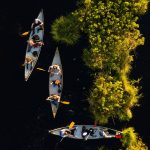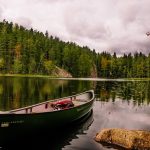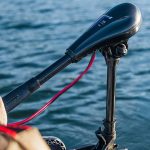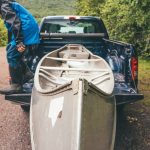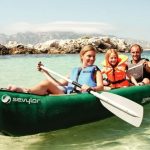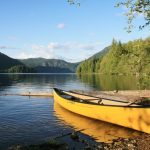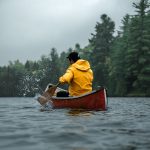Canoeing with your family is about more than just time on the water. Our guide to family canoes will help you ensure you buy the right boat for your trips.

This is our guide to the best canoes on the market in 2023.
We get it, picking a canoe can be hard work. There are loads of different canoes on the market and you want to make sure that the canoe you buy is perfect. Canoes aren’t cheap, after all, and you want to spend your hard-earned dollars on the best that your money can buy.
Our guide to the best canoes in 2023 will help you to select the right canoe for you and stop you from ending up with the wrong boat.
As an affiliate of Amazon and other retailers, we may earn a small commission when you buy via our links, at no additional cost to you. Thank you!
The Best Canoes of 2023 At a Glance:
- Best Solo Canoe: Old Town Discovery 119
- Best Budget Canoe: Mad River Canoes Adventure 14
- Best Tandem Canoe: Mad River Explorer 16T Formex
- Best Solo Fishing Canoe: Old Town Sportsman Discovery 119
- Best Tandem Fishing: Old Town Saranac 160
- Best Tandem Tripping Canoe: Nova Craft Prospector 16
- Best Lightweight Canoe: Wenonah Aurora Ultralight w/Aramid
- Best Inflatable: Sea Eagle TC16
- Best Square Stern Canoe: Esquif Mallard XL
- Best Aluminum Canoe: Grumman 17’ Double-End
- Best White Water Canoe: Esquif Pocket Canyon
Comparison Table: Best Canoes in 2023
| Model | Specs | Where to Buy |
 Old Town Discovery 119 | Size: 11’9″ x 32.5″ Weight: 50 lbs. Capacity: 500 lbs. | Old Town Canoe |
 Mad River Canoes Adventure 14 | Size: 14′ x 33″ Weight: 75 lbs. Capacity: 875 lbs. | Mad River Canoe |
Mad River Explorer 16T Formex | Size: 15’11” x 33″ Weight: 77 lbs. Capacity: 1100 lbs. | Mad River Canoe |
 Old Town Sportsman Discovery 119 | Size: 11’9″ x 32.5″ Weight: 56 lbs. Capacity: 354 lbs. | Amazon |
 Old Town Saranac 160 | Size: 16′ x 37″ Weight: 89 lbs. Capacity: 850 lbs. | REI |
Nova Craft Prospector 16 | Size: 16′ x 36″ Weight: 56 lbs. Capacity: 1000 lbs. | Nova Craft Canoe |
Wenonah Aurora Ultralight w/Aramid | Size: 16′ x 35″ Weight: 39 lbs. Capacity: not stated | Wenonah |
Sea Eagle TC16 | Size: 16′ x 38″ Weight: 64 lbs. Capacity: 915 lbs. | Amazon |
 Esquif Mallard XL | Size: 12′ x 36″ Weight: 59 lbs. Capacity: 600 lbs. | Esquif |
Grumman 17’ Double-End | Size: 17′ x 36″ Weight: 75 lbs. Capacity: 755 lbs. | Amazon |
 Esquif Pocket Canyon | Size: 16’5″ x 35″ Weight: 75 lbs. Capacity: 1000 lbs. | Marsport |
The Best Canoes of 2023
Best Solo Canoe: Old Town Discovery 119

Length: 11 ft. 9 in. (3.6 m)
Width: 32.5 in. (82.6 cm)
Weight: 50 lbs. (22.7 kg)
Capacity: 500 lbs. (226.8 kg)
Material: Three-layer polyethylene
It just wouldn’t be right if Old Town didn’t appear on this list. As the oldest manufacturer of canoes in the world, they have a history at the forefront of the industry.
Our top pick as a solo canoe is the Old Town Discovery 119. The Discovery 119 is one of the most popular solo canoes in the world, with its diminutive dimensions and large load capacity.
In our experience, the Discovery 119 is best suited to recreational lakes and gentle rivers but is nimble enough for some white water too. The shorter length limits the top speed and you won’t want to use the Discovery 119 for any long trips.
The three-layer polyethylene design makes this a sturdy canoe without being excessively heavy.
Pros:
- Nimble and easy to paddle
- Easy to transport
- High capacity
- Durable
Cons:
- No carrying yoke
- Shorter length limits the top speed
Best Budget Recreational: Mad River Canoes Adventure 14
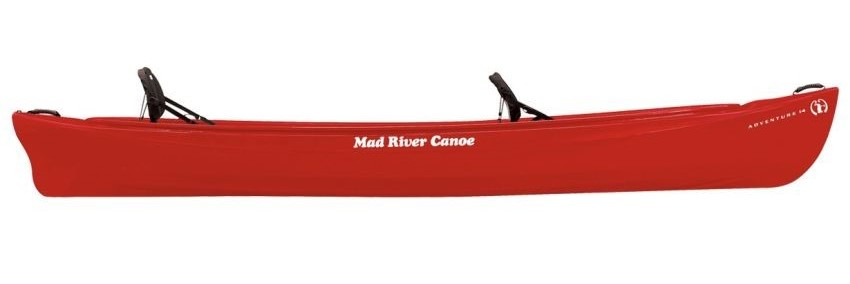
Length: 14 ft. (427 cm)
Width: 33 in. (84 cm)
Weight: 75 lbs. (34 kg)
Capacity: 875 lbs. (397 kg)
Material: Polyethylene
Mad River Canoes has made quality canoes for over fifty years and has made some of the most progressive designs on the market.
We chose the Adventure 14 as our best budget pick. Of all the canoes we tested over the years, this is one of the best affordable recreational canoes available.
The Adventure 14 is marketed as a 3-person canoe, but at 14 ft, we found that it is a little tight for three people. However, it makes an excellent recreational tandem canoe for days out at the lake or meandering down lazy rivers.
We’re impressed by the hull of the Adventure 14, which is designed to track effectively through the water. The elongated waterline at the stern helps to maintain a reasonably high speed.
At the bow, the Mad River Adventure 14 has a little rocker. We found that it helps ride high over the waves on days when the lake is a little choppy.
We also like the molded seats with pads and adjustable backrests to keep you out on the water for longer.
Pros:
- Affordable
- Three-person recreational
- Easy to paddle
Cons:
- Heavy
- Limited technicality of the design
Best Tandem Canoe: Mad River Explorer 16T Formex

Length: 15 ft. 11 in. (4.86 m)
Width: 35 in. (90 cm)
Weight: 77 lbs. (35 kg)
Capacity: 1100 lbs. (499 kg)
Material: T-Formex ABS Plastic
The Mad River Explorer is the benchmark in the Mad River Canoes range, so we just had to include it in this roundup. We had a chance to paddle the Explorer on many occasions, and it never failed to impress.
This model has been setting the standard for years for both solo and tandem paddling. The Explorer 16T Formex is a durable, all-around tandem canoe for paddlers of every level.
The T-Formex design uses layers of plastic for durability and weather resistance. At 77 lbs, this canoe is not the lightest on our list but probably one of the most durable.
We loved the slight v-shape of the hull, which gives the Explorer 16T Formex a good level of tracking and speed over the water without inhibiting the maneuverability.
In our experience, this canoe is great for any and every type of environment, from river days to long trips and fishing adventures.
Pros:
- Versatile design
- Strong
- High capacity
Cons:
- Heavy
- Expensive
Best Solo Fishing Canoe: Old Town Sportsman Discovery 119
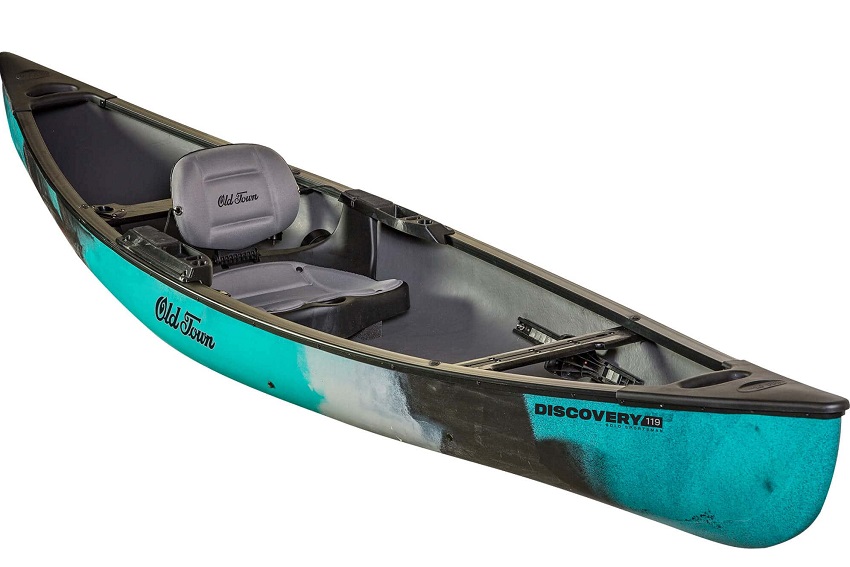
Length: 11 ft. 9 in. (3.6 m)
Width: 32.5 in. (82.6 cm)
Weight: 56 lbs. (25.4 kg)
Capacity: 354 lbs. (160.5 kg)
Material: Three-layer polyethylene
When it comes to solo fishing, the Old Town Sportsman Discovery 119 ticks all the boxes. The shorter stature of this canoe allows you to take your fishing to spots you wouldn’t normally be able to negotiate. In spite of the narrow build, we found that the Sportsman Discovery 119 is highly stable, though standing to cast takes some practice.
The raised and padded seat in the Sportsman Discovery 119 is a major selling point that sets it apart from most canoes on this list. The seat is designed for all-day comfort, with a fully adjustable backrest to support you.
We also loved the adjustable foot braces that keep you upright and engaged in your seat, essential for both paddling and casting. Rod holders are fitted on either side of the seat, with two more rear-facing holders situated behind the seat.
Pros:
- Reasonable capacity
- Plenty of onboard space
- Easy to paddle solo canoe
- Comfortable and adjustable seating
Cons:
- Standing to cast takes some practice
- No onboard gear organization
- The seat position can make it hard to move around and reach gear in the stern
Best Tandem Fishing: Old Town Saranac 160
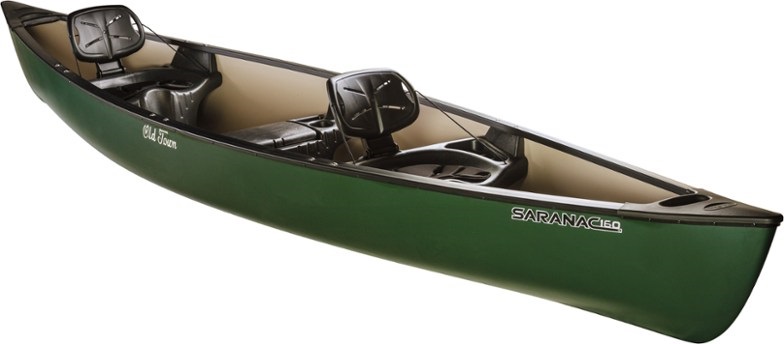
Length: 16 ft. (4.87 m)
Width: 37 in. (94 cm)
Weight: 89 lbs. (40 kg)
Capacity: 850 lbs. (385 kg)
Material: Thermoformed Polyethylene
The Old Town Saranac 160 is wider and more stable than most fishing canoes we tested. It also excels as a family-friendly recreational canoe. This makes it a popular choice among families that are keen on the occasional angling trip. A low rocker profile and long waterline give this canoe a reasonable top speed over the water and make for easy cruising.
The bow and stern seats of the Old Town Saranac 160 are padded and have adjustable backrests to keep you out on the water for longer. The central seat is more basic but also doubles as storage for your fishing essentials. Rod holders are fitted for each paddler and the large amounts of onboard space give you room to stow boxes, barrels, and coolers.
A minor downside our testers discovered is that at 89 lbs, this boat is quite heavy even for two people (especially if one of them is a kid). The Saranac is the heaviest canoe on our list, so if you plan trips that may include portages, this model is not for you.
Pros:
- Wide and stable
- Family-friendly three-seat design
- Onboard space
Cons:
- Heavy
Best Tandem Tripping Canoe: Nova Craft Prospector 16
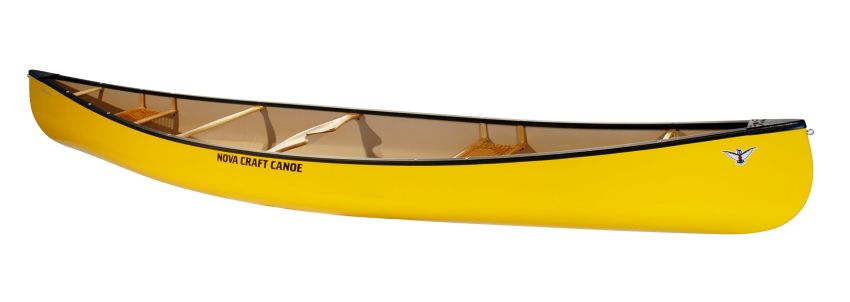
Length: 16 ft. (4.88 m)
Width: 36 in. (91.4 cm)
Weight: 56 lbs. (25.4 kg)
Capacity: 1000 lbs. (454 kg)
Material: TuffStuff Composite
When you’re out on a wilderness trip, you need a canoe you can rely on. The Nova Craft Prospector 16 is made from TuffStuff, a composite material made from basalt and Innegra fibers. These give you an impact-resistant, lightweight canoe that you can paddle for weeks at a time and haul over long portage trails.
The Prospector 16 has a well-rounded hull design, complete with a slight v-shape on the underside and a reasonable rocker profile. These combine to make this canoe capable in a range of environments, whether fully loaded up for a trip or empty, on a day out. You’ll get a dry ride in white water, while still maintaining a good speed and tracking on open water.
Pros:
- Versatile design for all environments
- Lightweight
- Durable
Cons:
- Expensive
Best Lightweight Canoe: Wenonah Aurora Ultralight w/Aramid
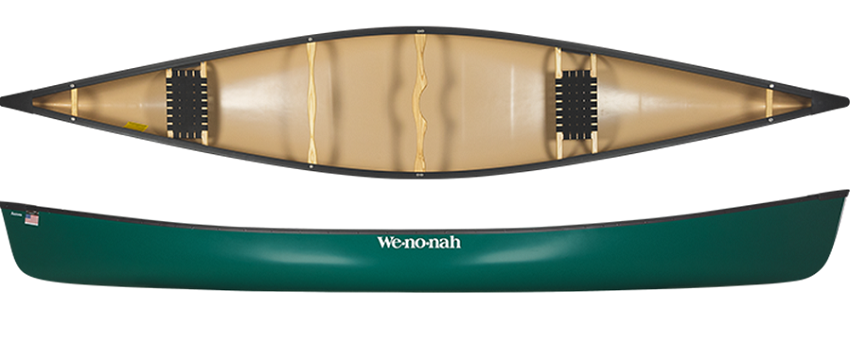
Length: 16 ft. (487 cm)
Width: 35 in. (89 cm)
Weight: 39 lbs. (17.6 kg)
Capacity: Not stated
Material: Aramid Composite
The Wenonah Aurora Ultralight uses aramid in its construction. This fiber is commonly used in airplane design, as well as in bulletproof vest construction, so you can rest easy knowing that your canoe is both ultralight and highly durable. These canoes are trip ready and can take on rough terrain and long portages.
The Aurora is a day tripper and river canoe at heart. The 16-foot length gives it a good speed over the water and couples with the strong v-shape hull that tapers quickly from the center point. This gives you a canoe that tracks effectively and holds its course, but that can still negotiate the tight turns of a river environment.
Pros:
- Capable in a range of environments
- Ultralight design
- Stable and predictable in wind and waves
Cons:
- Expensive
- Ultralight canoes are durable, but hard to repair if you do manage to break them on a trip
RELATED: Best Lightweight Canoes: Ultimate Guide and Reviews
Best Inflatable: Sea Eagle TC16
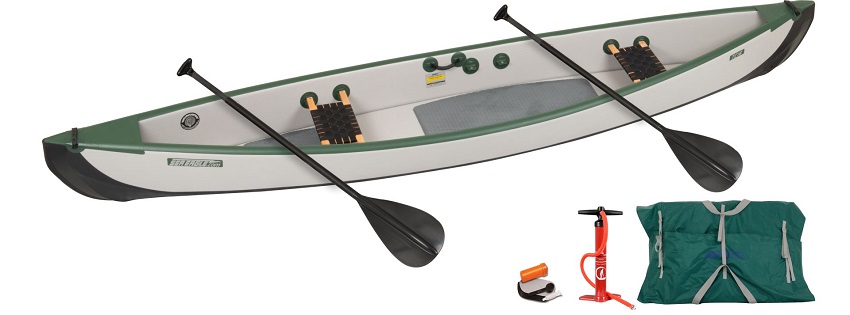
Length: 16 ft. (4.88 m)
Width: 38 in. (97 cm)
Weight: 64 lbs. (29 kg)
Capacity: 915 lbs. (415 kg)
Material: 1000 Decitex Reinforced
The Sea Eagle TC16 is our pick for the best inflatable canoe on the market at the moment. Inflatable canoes are an excellent choice for those who want to get out on the water, but who lack the storage space or load carrying capacity to own a hard-shell canoe.
Unlike most other inflatables we tested, the Sea Eagle TC16 uses drop-stitching not just on the floor but also on the sides, allowing you to inflate it to a higher pressure.
Alongside the high-pressure, rigid design, this is a wide canoe. Combined, these give you a stable platform that is confidence inspiring to beginners and children. The three seats can be removed and moved around, so you can paddle the TC16 with anywhere from one to three paddlers onboard.
Surprizingly, the TC16 is not the lightest canoe we tested. At 64 lbs, it is heavier than many hard-shell options on our list. So if your main reason for going the inflatable route is the weight, the TC16 could disappoint. The Wenonah Aurora Ultralight weighs a lot less (but costs quite a bit more).
Pros:
- Easy to store and transport
- Can change how many seats you have onboard
- Wide and stable
- Drop stitching for higher pressure
Cons:
- Has to be inflated when you reach the water
- Affected by the wind more than regular canoes
Best Square Stern Canoe: Esquif Mallard XL
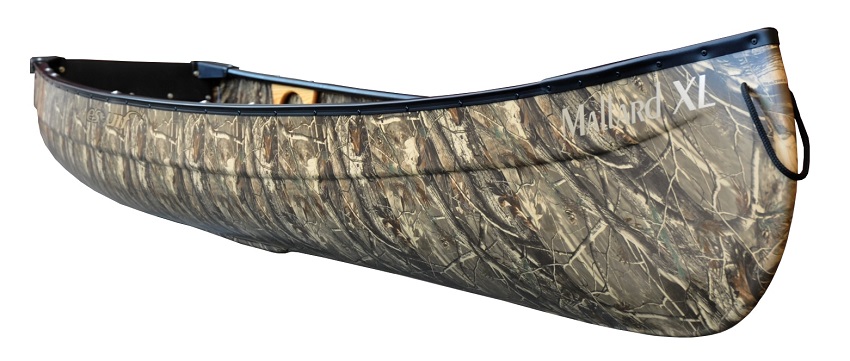
Length: 12 ft. (3.66 m)
Width: 36 in. (91.5 cm)
Weight: 59 lbs. (27 kg)
Capacity: 600 lbs. (273 kg)
Material: T-Formex
The Esquif Mallard is designed as a hunting and angling canoe with a square stern that is fully motor ready. Trolling motors make it easier to move between fishing spots, leaving you with more energy to fish and wasting less on moving your canoe. Want a larger model? Esquif makes a Mallard XL with a larger capacity.
The Mallard has a reasonable bow rocker to ride over waves and wake, but the wide hull area at the rear will limit top speed and tracking capabilities. But this isn’t really a canoe designed for long-distance paddling. You can take your fishing to spots you’ve never been able to before with the shallow draft and easy maneuverability of the Mallard.
Pros:
- Large open design for storage
- Trolling motor ready
- Stable for standing to cast or for hunting
- Sturdy T-Formex construction
Cons:
- Relatively low capacity
- Poor tracking without a motor
Best Aluminum Canoe: Grumman 17’ Double-End

Length: 17 ft. (5.18 m)
Width: 36 in. (91 cm)
Weight: 75 lbs. (34 kg)
Capacity: 755 lbs. (342.5 kg)
Material: Aluminum
Grumman was the first company to begin making aluminum canoes at the end of WWII and they have been making them ever since. The 17’ Double-End is popular with holiday camps throughout the US, as well as families and recreational canoeists. The aluminum design makes this an extremely hard-wearing canoe and you can store it outside in just about any weather.
The Grumman 17’ Double-End is designed to make canoeing accessible. The wide profile makes this a stable and confidence-inspiring canoe for beginners or younger paddlers. Low sides make it easier for younger paddlers to reach over the edges, giving them more control with the paddle and more ownership of their paddling.
Pros:
- Extremely durable
- Can be stored in any weather
- Beginner friendly
Cons:
- Aluminum boats are noisy to paddle
- Gets cold in winter
- Not the most comfortable seats
Best White Water: Esquif Pocket Canyon
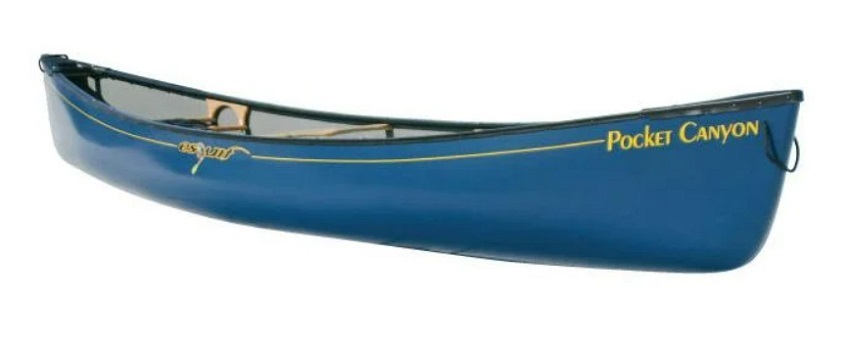
Length: 16 ft. 5 in. (5.02 m)
Width: 35 in. (88.9 cm)
Weight: 75 lbs. (34 kg)
Capacity: 1000 lbs. (455 kg)
Material: T-Formex
The Esquif Canyon is a crossover canoe that is designed to tackle the biggest rapids you can throw at it, while still being able to cover long distances on a trip. The shallow v-shaped hull and long waterline give this canoe superior tracking capabilities, allowing you to keep going when the weather gets rough. A reasonable rocker profile combines with high sides to keep you riding high and dry through waves and rapids.
The Canyon has a load capacity of 1000 pounds, more than enough for two adults and all of their tripping gear for days, even weeks on the water. The internal setup combines the comfort of two woven seats with the additional lateral strength of extra thwarts, to keep you safe on the river. While the Canyon is a great touring and white water option, if you’re looking for out-and-out white water fun, the Pocket Canyon is a day-tripping river machine.
Pros:
- Trip ready white water canoe
- Deep sides and rocker profile for a dry ride
- Large carrying capacity
Cons:
- Expensive
- The smaller model might be better suited to narrow and tight rivers
What are the Different Types of Canoe
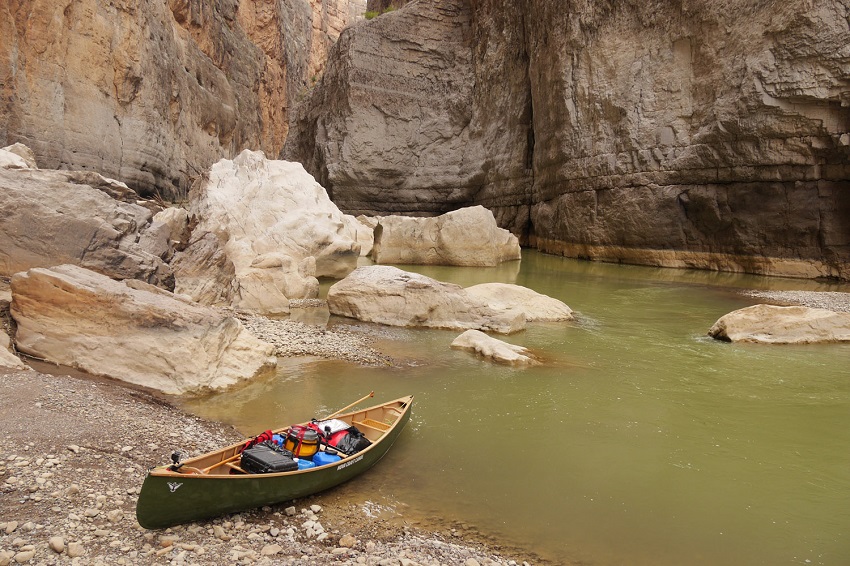
You might be looking at the list of canoes and wondering why there are so many different types. After all, how different can canoes really be? Well, in a moment we’ll look at what makes canoes suitable for different environments and the features that affect their performance, but first, let’s look at the different styles of canoes.
Recreational
Recreational canoeing is by far the most popular form of canoeing in the US. Recreational canoeing takes place on calm lakes or rivers, or ocean bays, and includes everyone from beginners or families, to experienced canoeists. This form of canoeing doesn’t require a specialist canoe, but you would generally be looking for a stable and comfortable canoe over one that can go long distances.
Fishing
Canoe fishing is still popular in the US, despite the rise of fully decked-out fishing kayaks. Fishing canoes are among the most stable on the market, designed to stand and cast without any fear of falling overboard. There are also plenty of square stern canoes, or motor-ready canoes, that you can mount a canoe trolling motor on for easy cruising.
Tripping
Canoe tripping is the quintessential canoe experience. Loading up your canoe for an overnight adventure, heading out into the wilderness, and exploring new boundaries was the reason the canoe became popular in the first place. For canoe tripping, you need a longer canoe capable of covering distances and carrying camping equipment. It also helps if it’s light enough to carry over portage trails too.
White Water
White water canoeing requires a reasonable level of skill. Negotiating your canoe down wild rapids and white water chutes can be exhilarating if done right, or nerve-wracking if not. A white water canoe should be shorter and more maneuverable than a tripping canoe, ideally with a little more rocker to ride over waves.
Canoe Buying Guide: Factors to Consider
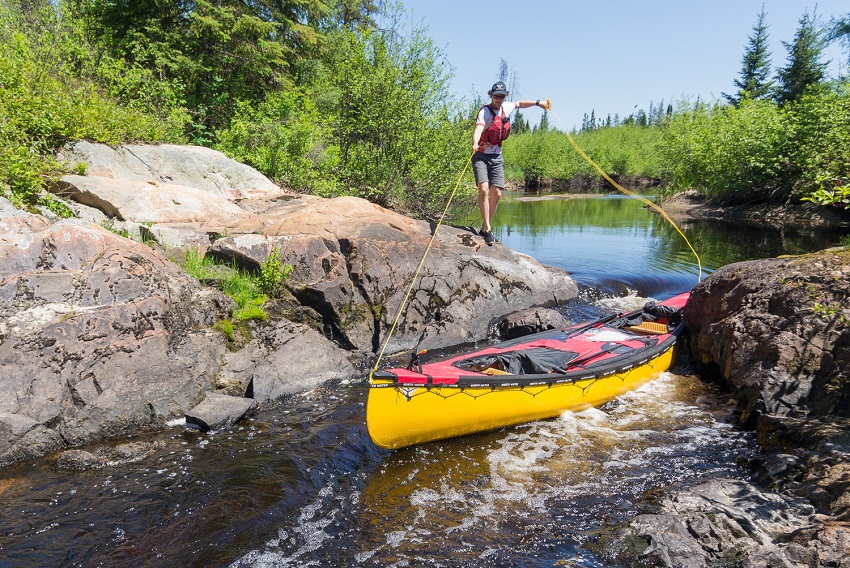
Length
The most common starting place for choosing a canoe is the length. In short, longer canoes are quicker and hold their course better than shorter canoes. The longer waterline helps the canoe to grip against waves and to maintain a course through the wind, making them the ideal choice for tripping.
Longer canoes can feel unwieldy to paddle though, especially if you’re still getting to grips with solo canoeing. They also tend not to turn as effectively, making them harder to negotiate in tighter environments like rivers.
Most solo canoes are around 13 – 15 feet long, with tandem or three-person canoes ranging from 15 – 17 feet. When you’re looking to buy your canoe, make sure you have an appropriately long area to store it in.
Width
Canoe width varies between styles of the canoe, but usually ranges between 34 – 37 inches, measured between the gunwales at the widest point. There are canoes that are both wider and narrower than these measurements, but they’re not common.
Narrower canoes can take some getting used to and feel less stable at first. Because they have less contact with the water, they generate less drag and therefore are quicker. A lot of longer tripping canoes are slightly narrower, giving them a higher top speed and cruising ability.
If you’re looking for stability, it can be found in width. Fishing canoes and recreational canoes are among the widest on the market, offering unparalleled stability and confidence. These canoes won’t break any speed records, but you will be able to stand and move around in them without feeling like you’re going to end up in the water.
Rocker
The rocker of a canoe is the curvature of the boat from the bow to the stern. The more banana-shaped your canoe, the higher the rocker profile. Flatter canoes would be described as having a lower rocker profile.
A higher, or more pronounced rocker raised the bow and stern of the canoe out of the water slightly. This makes your canoe ride higher over the water and gives you more clearance through waves. Canoes with higher rocker are better suited to white water or ocean swell than flatter canoes.
The downside to canoes with a higher rocker profile is that they can lack effective grip that can help you track on a course. This is especially noticeable against the wind where you can be blown around more easily. The bow and stern of a flatter canoe will remain in the water and help you to stay on course, but you may be susceptible to waves breaking over your canoe.
Weight
At some point, you’re going to have to move your canoe around off the water. This could be lifting your canoe onto the roof of your car to load up for the river or portaging along a trail for several miles. The more your canoe weighs, the harder and more tiring it will be to move around on the land.
Ultimately, it would be great if all canoes were light enough to carry single-handedly, but that’s not the case. The majority of canoes weigh upwards of 55 pounds and require at least two adults to move them around.
Lightweight and ultralight canoes are among the most expensive on the market. These canoes require specialist materials for their construction and these command an associated cost. Often, these canoes are made from fiberglass or carbon composite materials, making them less resistant to impacts from rocks, or landings on harsh beaches.
Capacity
The capacity of a canoe is worked out on how much weight it can carry before it is no longer safely afloat. If you were to fully load up your canoe with the stated capacity and try to paddle it, you would have a tough time staying above water. To remain within optimal performance for a canoe, you should load up no more than 70% of the stated capacity.
Your capacity in a canoe is inclusive of all paddlers onboard, as well as their equipment and any extra gear you are carrying. Remember that if you get wet, you are going to weigh more than when you are fresh and dry. Canoes with higher capacity will offer you a range of options, but are larger and can be harder to paddle when they’re empty.
Solo, Tandem, or Three-Seater
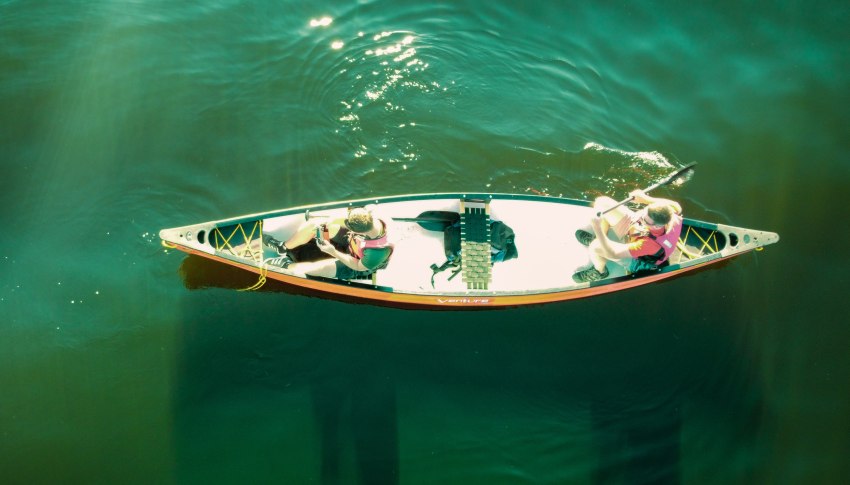
This is quite a straightforward question; are there enough seats in your canoe for the number of canoeists? If the answer is yes, then you’re good to go.
The majority of canoes are tandem, with a seat at the bow and the stern. Most tandem canoes can be paddled solo, too, with some solo paddlers preferring to turn the canoe around and sit on the front seat, but facing the rear of the canoe. Additional temporary seats can be added to tandem canoes for a third paddler.
If you know you are always going to be heading out solo, then there are shorter and more agile canoes designed for one paddler. The seat in these canoes is usually more central to give you greater control and more efficient paddling. Solo canoes are available in all styles.
Three-person canoes are usually aimed at families, with the central seat suited to younger paddlers. These canoes tend to be recreational, but can often be taken into more technical environments if you have the skills and knowledge to do so.
Material
The most common material for canoes to be made from is rotomolded polyethylene. This affordable, easy-to-mold plastic is sturdy enough to withstand years of use and abuse and is used in the manufacture of canoes for all disciplines. Rotomolded polyethylene is heavy though, and susceptible to damage from exposure to UV and rough weather, so you should store your canoe accordingly.
ABS laminate canoes use layered sheets of plastic to create a rigid and sturdy canoe that is capable of standing up against rough and rocky rivers. These canoes are slightly lighter than rotomolded plastic canoes, but also have the advantage that the outer layer is UV resistant.
Aluminum canoes are undoubtedly the most durable on the market. These canoes will last decades and can be stored outdoors no matter what the weather. Aluminum canoes tend to be fairly basic and can be noisy and cold to paddle through.
Wooden canoes are not that common nowadays. They have unparalleled visual appeal and they paddle excellently, but they lack durability. Handcrafted wooden canoes are as much an art form as they are a craft nowadays and are used more by purists than your average canoeist.
Composite canoes have fiberglass or carbon worked into the construction. These materials add stiffness and reduce the weight of your canoe, making some of the lightest boats on the market. However, these materials are expensive and tend to be less durable than plastic models, potentially leaving you exposed on a long trip.
Features
The majority of canoe features are elements of their hull or design that make them suited to particular environments. However, there are some canoes that offer something a little extra to really excel.
Fishing canoes are usually the most feature-laden, with areas for coolers, comfortable high-backed seats, gear rails, and rod holders all built into some models. There are three-person canoes with a central seat that doubles as a cooler. Or there are canoes with square sterns that can have a motor mounted for trolling.
If you need these features, they cannot be passed up. However, if you have a canoe that is fully loaded with features you don’t use, they just get in the way and add excess weight that you have to trawl around with you. Decide early whether you need the features, and remember that many of them can be added retrospectively to your canoe.

